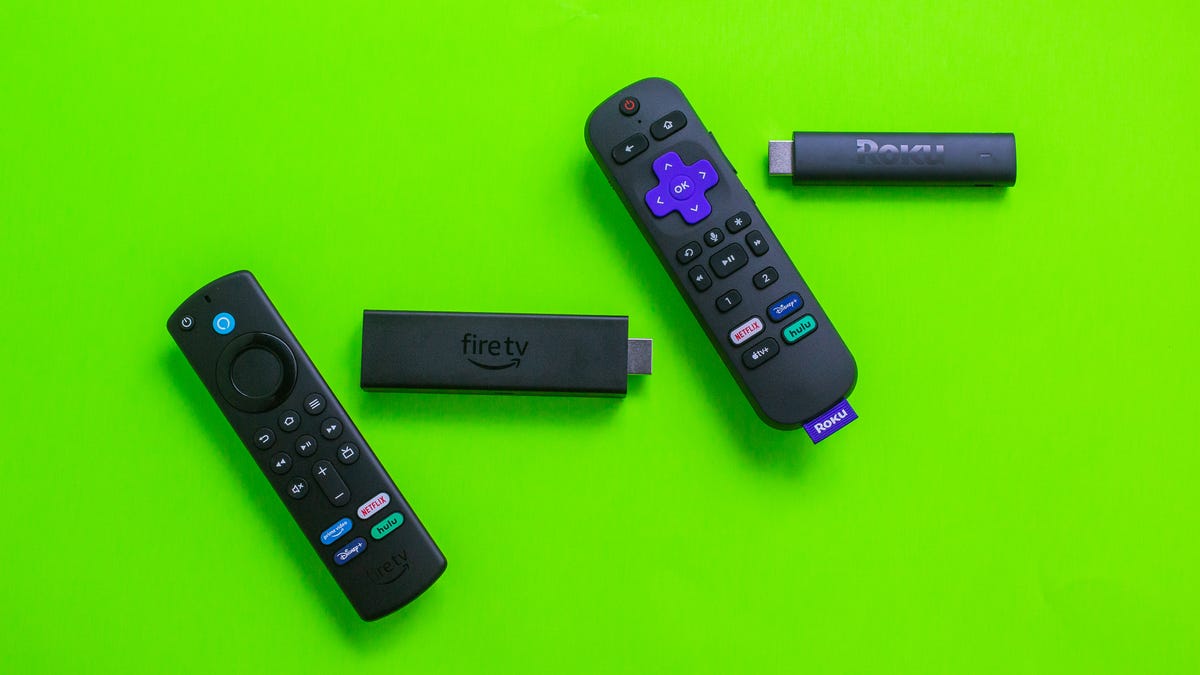Firestick vs Roku : Which Streaming Device Saves You More Money
Both Firestick and Roku streaming devices start at $50, though you can find them at better prices. The Fire TV Stick 4K sells currently available for $28, and the Roku Streaming Stick 4K costs $29.
Each device brings its own strengths to the table. The Fire TV Stick 4K features 8GB storage and 2GB memory. Roku doubles the storage to 16GB but includes just 1GB memory. A typical Roku setup takes about 15 minutes to complete, while the Fire TV Stick needs extra time because of multiple updates.
Your choice between Roku and Firestick really depends on your preferences. Roku shines with its accessible interface and clean menu layout. The Fire TV Stick pairs strong Alexa integration with its interface, which some users might find a bit busy.
The differences between these streaming devices deserve a closer look to help you pick the right one that matches your entertainment needs and budget.
Hardware Specifications - roku vs firestick
The hardware inside Firestick and Roku streaming devices shows substantial differences. The Roku Streaming Stick 4K and Amazon Fire TV Stick 4K each bring their own technical advantages that affect your streaming experience.
Processing power and performance
Your streaming device's brain determines how well it handles content. The Fire TV Stick 4K packs 2GB of RAM, which lets you switch between apps easily. The Roku Streaming Stick 4K has 1GB of RAM , and this might slow things down if you use multiple apps.
Daily use shows clear performance differences. The Fire TV Stick 4K Max loads apps almost instantly and navigates smoothly. The standard Fire TV Stick 4K can lag sometimes, especially on the home screen.
Roku delivers steady performance throughout. Users found it rarely buffers, even with tricky apps like Paramount+. The device switches between apps and menus faster than the Fire TV Stick.
Storage capacity and expandability
Storage space sets these devices apart. The Roku Streaming Stick 4K comes with 16GB of internal storage, twice the Fire TV Stick 4K's 8GB. You can install more apps without storage concerns on the Roku.
These sticks don't have SD card slots for extra storage. Both let you connect external storage through USB ports, but this works mainly fo;r loading apps rather than expanding system storage.
Connectivity options: roku vs firestick
These streaming rivals differ substantially in how they connect. The Fire TV Stick 4K supports Wi-Fi 6, which means faster and more stable internet on compatible networks. The Roku Streaming Stick 4K uses dual-band Wi-Fi 5 technology.
Roku shines in larger homes with its long-range Wi-Fi feature. The Streaming Stick 4K's USB power cable has a built-in Wi-Fi receiver away from the device. This cuts wireless interference and extends the range up to four times.
Both devices keep it simple with physical connections. They use HDMI to connect to your TV - Fire TV Stick 4K with HDMI 2.1 and ARC support, Roku with HDMI 2.0b. USB powers both devices, with Fire TV using Micro-USB and Roku using standard USB.
The Fire TV Stick's thicker build makes it tough to plug into crowded HDMI ports, but Amazon includes an HDMI adapter to help.
User Interface Experience: Is Roku or Firestick Better?
The firestick vs roku battle comes down to how you interact with your TV through their interfaces. The Roku Streaming Stick 4K and Amazon Fire TV Stick 4K each take their own path to deliver your streaming experience.
Navigation and menu layout
Roku shines with a simple interface. You can arrange your apps just like on your phone, and they stay front and center. This clean approach helps you find your content fast without extra distractions on screen.
The Fire TV interface looks great but needs more work to use. The screen fills up with TV shows and movies instead of focusing on apps. These suggestions rarely match what you watch or want to see. Simple tasks need more clicks on Fire TV.
These devices handle search in completely different ways. Roku shows clear results with prices upfront. You'll know right away if content costs money or comes free with your subscriptions. Fire TV results can be messy with multiple options that don't quite fit. You'll only see one main service at first and need extra clicks to find "more ways to watch".
Ad presence and placement
Fire TV loves to show Amazon Prime content and ads. The home screen loads up with Prime Video suggestions, which works great for Prime fans. Other users might feel overwhelmed when their TV screen turns into "a billboard" for various services.
Roku takes a better approach. Ads stay on one side while your apps remain neatly arranged in the middle. This creates a better balance that doesn't feel like constant advertising.
Customization options
Roku lets you make the interface your own. You can move apps around and pick theme packs that change your wallpaper, screensaver, and system sounds. Free themes range from space and western to jungle designs, plus special movie and show themes.
Fire TV has pulled back on customization lately. New updates block users from changing remote buttons or adding custom home screens. The system decides which channels show up first, taking away manual app organization.
Roku keeps things consistent on all their devices, which makes switching between Roku products a breeze. Your choice really depends on what matters more - a neutral, app-focused setup with Roku or Amazon's content-heavy approach with Fire TV.
Remote Control Features: Convenience vs Cost
Remote controls play a crucial role in the firestick vs roku debate. They can substantially affect your daily usage and ongoing costs. The Fire TV Stick 4K (https://amzn.to/3EgCyM2) and Roku Streaming Stick 4K (https://amzn.to/42zhTMB) each come with their own unique remote experiences.
Voice command capabilities
Fire TV Stick's remote shines with its Alexa integration. Alexa does more than just search for content - you can manage smart home devices, check weather updates, and get answers right on your screen. Echo device owners can control their Fire TV without touching the remote.
Roku's voice features focus mainly on content search and playback control. The system works with Google Assistant and Alexa through separate smart speakers. Users need to add "Roku" after each command ("OK Google, launch Hulu on Roku"). This makes the interaction less smooth.
TV control integration
Each remote lets you control your TV's power and volume. Their designs are quite different. Roku's remote feels chunky with its round shape and traditional arrows plus "OK" button. Fire TV's remote is slim - which means it might slip between your couch cushions - and features a navigation wheel.
Fire TV has an edge with external device control. Your Fire TV remote can handle soundbars and AV receivers, while Roku sticks to TV controls only. Both companies offer phone apps that work as backup remotes.
Battery life and replacement frequency
Battery usage sets these devices apart. Many Roku users deal with fast-draining batteries. Some need new ones every 1-2 weeks, or in extreme cases, every other day. This issue comes up often in online discussions.
Roku's battery drain happens because of:
Signal interference from nearby electronics
Wi-Fi congestion affecting remote-device communication
Private listening feature (on applicable models)
Hardware issues with certain remote models
Your Roku remote's battery life improves when you:
Use quality alkaline batteries
Keep a clear path between remote and device
Move electronics that might interfere away
Try the Roku mobile app instead
Fire TV remotes handle battery life better. This advantage matters when you're deciding which is better, Roku or Firestick for your budget and long-term costs.
Content Discovery: Finding What to Watch
The Fire TV Stick 4K and Roku Streaming Stick 4K show their biggest practical differences in content discovery capabilities for the firestick vs roku comparison.
Search functionality comparison
Roku stands out with its universal search function. This feature lets you search all streaming platforms at once and shows every available source for a title with its price. The platform makes searching by director, actor, or genre simple. Results are clear and focus on pricing - you'll know right away if content comes free with your subscriptions.
Fire TV's search works better now but still favors Amazon's ecosystem. The search results usually display just one main service at first. You need to click "more ways to watch" to see other options. This approach often leads to confusing results and false matches.
Recommendation algorithms
The way these devices suggest content really sets them apart in the roku vs firestick debate. Fire TV's algorithm creates suggestions based on what you watch, which can help you find new content. The downside? These suggestions often highlight Amazon Prime shows and movies no matter what you actually watch.
Roku takes a different path. The platform doesn't push content from any specific provider. It simply helps organize your chosen apps. Yes, it is this neutral approach that makes Roku a better choice for users who want an unbiased experience rather than personalized suggestions.
Content organization
The way content gets organized helps answer which is better, roku or firestick for different users. Roku puts your apps front and center. You can arrange them just the way you like. The home screen won't show what you're watching inside apps - you'll need to open each one to see your content .
Fire TV's home screen tries to bring all content together. You might see your half-finished YouTube videos or Netflix shows right on the main screen . This integration feels either helpful or messy based on how you like things organized, especially since Amazon's content always seems to get the spotlight.
Smart Home Integration: roku stick vs fire stick
The Fire TV Stick 4K and Roku Streaming Stick 4K are more than entertainment devices. These streaming devices serve as control centers that change your connected home's functionality.
Alexa vs Google Assistant compatibility
The firestick vs roku comparison reveals distinct differences in voice assistant integration. Fire TV devices come with built-in Alexa functionality that goes way beyond the reach and influence of content searching. Alexa's capabilities let you control compatible smart home devices, check weather reports, and see answers to questions on your screen. This creates a unified control system for your entire smart home.
Roku takes a different path. It works with both Alexa and Google Assistant through external speakers. Notwithstanding that, this integration needs you to add "Roku" after every command ("OK Google, launch Hulu on Roku"). The experience becomes less accessible. Roku's dual compatibility provides flexibility but lacks the smooth integration of Fire TV's Alexa implementation.
Smart home device control options
Fire TV's Alexa integration gives substantial advantages to smart home enthusiasts in the roku vs firestick debate. To name just one example, see how you can press and hold the Alexa button on your Fire TV remote to control smart lights or adjust your thermostat . Your Fire TV Stick becomes a natural extension of that ecosystem if you already own Alexa-enabled devices.
Roku has developed its own line of smart home products. These products can integrate camera feeds with Roku TVs or streaming devices. This feature remains new and limited to Roku Home devices.
The choice between which is better, roku or firestick for smart home control depends on your current setup. Fire TV Stick provides reliable integration if you have invested in an Alexa-centric smart home with devices from brands like Philips Hue, Ring, or TP-Link. Roku might better match your needs if you prefer Google's ecosystem or value flexibility between assistants, despite its less smooth implementation.
Firestick vs Roku Comparison
Feature | ||
|---|---|---|
Price | $28 (current) | $29 (current) |
Storage | 8GB | 16GB |
RAM | 2GB | 1GB |
Wi-Fi Standard | Wi-Fi 6 | Wi-Fi 5 (dual-band) |
HDMI Version | HDMI 2.1 with ARC support | HDMI 2.0b |
Setup Time | Multiple updates extend setup | Quick 15-minute setup |
Interface Design | Amazon-focused content display | Clean app-based layout |
Ad Experience | Heavy Amazon Prime promotions | Minimal ads on one side |
Voice Assistant | Complete Alexa integration | Works with Alexa and Google Assistant for search |
Remote Battery Life | Standard battery usage | Batteries need replacement every 1-2 weeks |
Search Functionality | Amazon content priority needs extra navigation | Clear pricing with unified platform search |
Smart Home Integration | Full Alexa smart home control | Works through external speakers only |
Customization | Few personalization choices | Rich themes and flexible app arrangement |
Wi-Fi Range | Standard coverage | Better range with built-in Wi-Fi receiver |
Performance | Home screen shows occasional lag | Smooth playback with minimal buffering |
what's better roku or firestick
The Fire TV Stick 4K and Roku Streaming Stick 4K give users clear choices when picking their streaming device. These $30 devices pack great value, and each one brings something special to the table.
Amazon's Fire TV Stick 4K really shines with Alexa and smart home features. The device fits naturally into Amazon's ecosystem, and its interface pushes Amazon content front and center. The 2GB RAM helps users switch between apps without any lag.
The Roku Streaming Stick 4K comes with an easy-to-use interface and plenty of storage space at 16GB. Users love its neutral approach to content and the way it searches across all streaming services. The remote's frequent need for new batteries might add up over time.
Your current tech setup and viewing habits should guide your choice between these devices. Amazon Prime members and smart home fans will get more from the Fire TV Stick 4K. People who want a simple, unbiased streaming experience with lots of storage space will find Roku a better fit.
These budget-friendly devices deliver amazing 4K streaming quality. You can't go wrong with either one to upgrade your TV setup.
FAQs
Q1. Which streaming device offers better value in 2025: Firestick or Roku? Both devices offer excellent value at around $30. The Fire TV Stick 4K excels in Alexa integration and smart home control, while the Roku Streaming Stick 4K stands out with its user-friendly interface and larger storage capacity. The best choice depends on your specific needs and preferences.
Q2. How do Firestick and Roku compare in terms of user interface? Roku offers a simple, app-focused layout with limited ads contained to one side. Firestick has a content-forward, Amazon-centric interface with heavier promotion of Amazon Prime content. Roku allows more customization, while Firestick's interface can feel cluttered to some users.
Q3. What are the main differences in voice control capabilities between Firestick and Roku? Firestick features full Alexa integration, allowing for comprehensive smart home control and advanced voice commands. Roku offers basic voice search functionality and works with both Alexa and Google Assistant through external speakers, but the integration is less seamless.
Q4. How do Firestick and Roku compare in terms of content discovery? Roku provides a universal search across platforms with clear pricing, making it easier to find content from various services. Firestick's search prioritizes Amazon content and may require extra clicks to see all viewing options. Roku takes a more neutral approach to content recommendations, while Firestick tends to highlight Amazon Prime offerings.
Q5. Are there any notable differences in hardware specifications between Firestick and Roku? Yes, there are several differences. Firestick 4K has 8GB storage and 2GB RAM, while Roku Streaming Stick 4K offers 16GB storage but only 1GB RAM. Firestick supports the newer Wi-Fi 6 standard, while Roku uses Wi-Fi 5. Roku includes an extended range Wi-Fi receiver in its power cable, which can be beneficial in larger homes.









